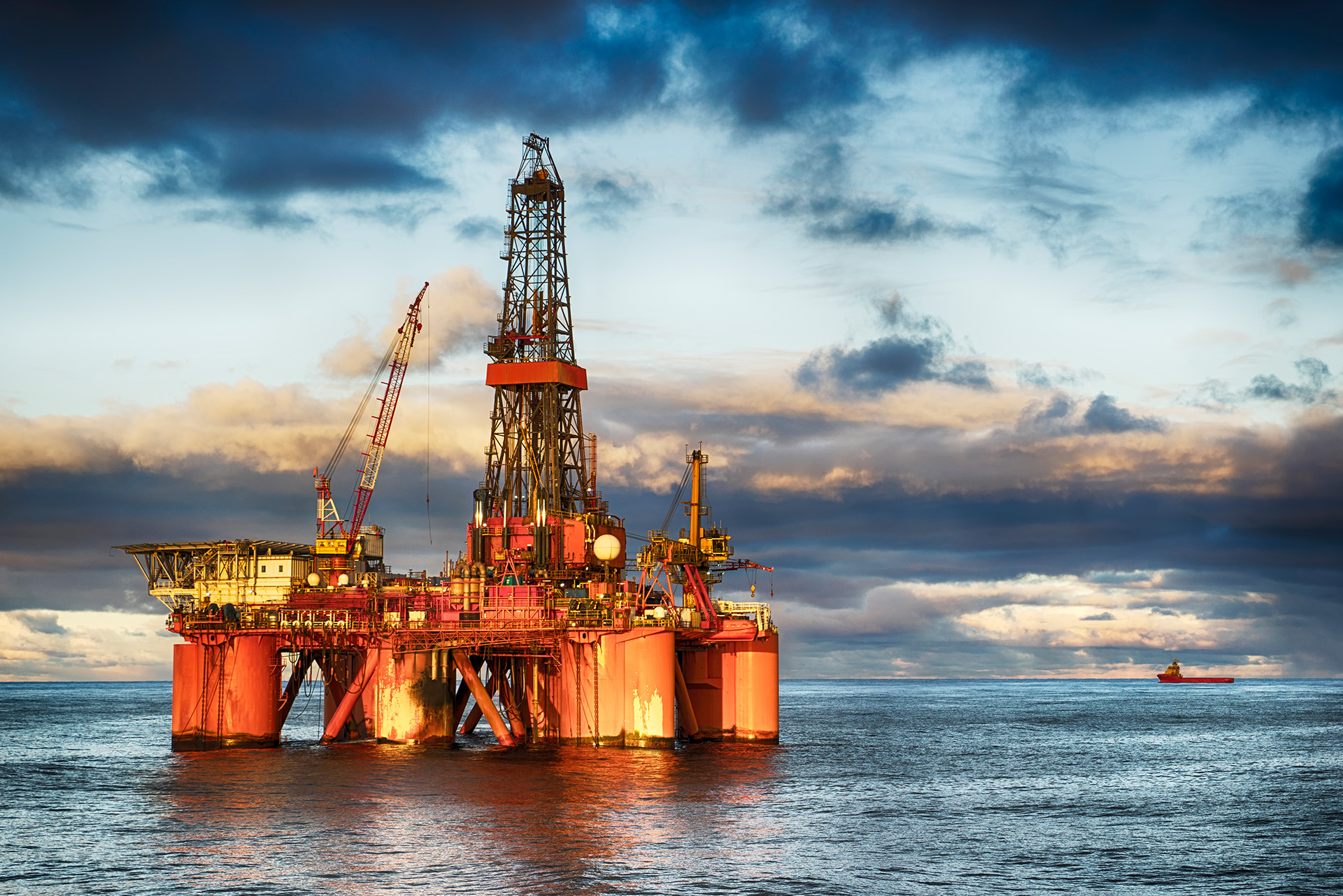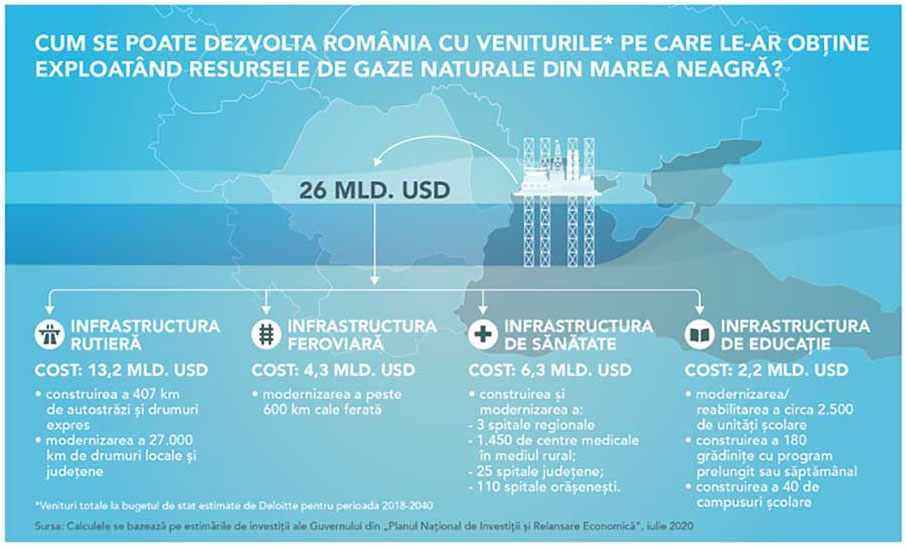Romania is one of the world's oldest producers of crude oil and natural gas. The history of exploitation stretches back more than a century, but today, after periods of intensive exploitation, onshore production is in decline. Under the murky waters of the Black Sea, however, nature has created reservoirs capable of hosting important natural gas resources and reserves. The deposits here are so promising they could make Romania a new Norway. It's up to us what we do with these deposits, to make them either a bonanzaor fata morgana (a beautiful dream).
Onshore (onshore), Romania was the first country in the world to officially record crude oil production in 1857. As for natural gas, the first wells that led to the start of national natural gas production were drilled in 1908 in Sărmășel (Mures county).
Oil rig Gloria makes first searches in the Black Sea
By comparison, in the offshore area, the first seismic data acquisition in the Black Sea basin started in 1969 and it was not until 1976 that the offshore oil drilling rig Gloria drilled the first exploration well (source: "Black Sea hydrocarbons - between challenges and risks"The aim of these works was to increase the national production of hydrocarbons - i.e. oil and natural gas, by accessing the potential of the Black Sea continental shelf.
"Initially, Ovidiu Est Well 1 was located in an area where the water was 84 meters deep. The platform was designed for waters with a maximum depth of 90 meters and waves as high as 12 meters," data from the Romanian Association of Offshore Concessionaires in the Black Sea (RBSTA).
The result was negative, and the second drilling was carried out in the perimeter XV Midia, the result was again negative. The third attempt was made in the XVIII Istria perimeter, where the borehole drilled in 50 meters of water depth, made its first significant oil discoveries in 1980 (Lebăda). Work followed to build the first production platform in 1984, as well as a 64 km pipeline to transport oil to the mainland.
1987, production starts in the Black Sea
It was only in 1987, 11 years after the start of exploration, that the first production of hydrocarbons from the Black Sea was recorded.
Subsequently, "after more than 100 exploration drillings, new oil and gas fields were discovered: Sinoe (1988), Portița (1990), Doina (1995), Cobălcescu (1997), Pescăruș (1999), with relatively small reserves. Between 1988 and 2001, 6 other production platforms were built on the continental shelf at a water depth of up to 150 m. The platforms follow a SV-NE alignment, about 80-100 km from the coast," the paper says. "Black Sea hydrocarbons - between challenges and risks".
Exploration work continued and after 2001, new oil fields were discovered in the Shield area.
The structures exploited today are located in shallow waters.
"At present, about 8% of the nation's crude oil and condensate production comes from offshore fields, with the remainder covered by onshore production," according to Deloitte data published in the study "The contribution of hydrocarbon exploration and production projects in the Black Sea to the development of the Romanian economy".
2009 and Romania's historic victory in The Hague
A strategic moment for the country comes in 2009, on February 3, when the Court of in The Hague ruled in Romania's dispute with Ukraine over the maritime delimitation of the Black Sea.
"For Romania, the judgment was a remarkable diplomatic success in our recent history, by recognizing the jurisdiction and sovereign rights of our country over 9,700 km2 of continental shelf and exclusive economic zone in the Black Sea", says the Ministry of Foreign Affairs (MFA).
This success was also "the first and only extension of Romania's sovereign jurisdiction and sovereign rights since the Great Union of 1918", the MFA further explains. In total, it took 40 years to definitively settle the political dispute between Romania and Ukraine over the delimitation of the Black Sea.
Thus, "Romania's offshore area currently covers 22,000 square kilometers and reaches depths of more than 1,000 meters", says Deloitte in the study.
Shortly after the victory in The Hague, the National Agency for Mineral Resources is auctioning the concession of 11 offshore perimeters through Round X. Of the 11 perimeters, five were in Romania's newly won area. On the website of the Romanian Association of Offshore Concessionaires in the Black Sea (https://rbsta.ro/ro/despre-noi/#cinesuntem) find the interactive map of offshore perimeters in Romania.
2012: ExxonMobil-OMV Petrom consortium makes largest single discovery in the Black Sea
The summer of 2009 marked another extremely important moment in Romania's history: in partnership with a subsidiary of US giant ExxonMobil, OMV Petrom began an exploration campaign to assess the hydrocarbon potential of the Neptun perimeter in the Black Sea. Between 2009-2010, the two companies acquired more than 3,000 square kilometers of 3D seismic data on the Neptun block, using state-of-the-art technology. The work was carried out with one of the world's largest seismic acquisition vessels, GeoCeltic (details, HERE).
Between December 2011 - March 2012, ExxonMobil and OMV Petrom drilled the well Domino-1, Romania's first deepwater exploration well to confirm the presence of natural gas. Domino-1 reached a total depth of more than 3,000 meters below sea level. The Deepwater Champion drillship was chartered for these operations. In 2012, the Domino-1 well identified recoverable reserves of some 42-84 billion cubic meters of natural gas, "becoming the biggest single discovery in the Black Sea to date", according to Deloitte's 2018 study.
From November 2012 to June 2013, ExxonMobil and OMV Petrom conducted a second 3D seismic campaign, covering more than 6,000 square kilometers in the deep offshore Neptun Block. This was the largest 3D seismic campaign ever recorded in the Black Sea (see HERE source).
Plus, the two companies have procured the Ocean Endeavor platform - one of the most technologically developed drilling rigs in the world - to resume exploration drilling on the Neptun Deep offshore block. The platform is designed to drill in water up to 2,400 meters deep and a total drilling depth of up to 10,600 meters. Its mobilization in 2014 alone cost a whopping €500 million (find details and video of the giant Ocean Endeavor's unprecedented operation to bring the giant Ocean Endeavor to the Black Sea, HERE).
In 2015, the Lukoil-Pan Atlantic-Romgaz consortium discovers further reserves of around 30 billion cubic meters.
So, thanks to state-of-the-art technology and some 3.5 billion dollars of exploration investment, huge deposits for Romania have been identified in the deep offshore. However, they are still not accessible. Even now, almost 10 years after the historic Neptun Deep discovery, the authorities have failed to respond to investors' demands for an attractive, predictable and stable fiscal framework. These conditions are absolutely essential for investors, who need to spend billions of euros to bring these resources to the surface.
Huge risks of losing the Neptun Deep project
"The Black Sea may become a small North Sea, as there are over 200 billion cubic meters of gas deposits here, but 6-7 billion dollars is needed to extract them"said Sorin Gal, director general of ANRM, at the end of last year (source HERE).
In the absence of a competitive, stable and predictable legislative and fiscal framework, final investment decisions were postponed and some investors began to pull out. On top of all this, the coronavirus pandemic broke out, which led to a collapse in demand for fuel and lower oil prices.
In addition, the European Green Deal, with its highly ambitious environmental targets for 2030 and 2050, puts high pressure on fossil fuel investments and creates a huge risk of losing the Neptun Deep project, as the Federation of Oil and Gas Employers points out (details, HEREThus, any delay in implementing the necessary legislative changes could jeopardize the viability of the investments.
Investors are still hoping that the state will take the necessary decisions so that it is not just the local oil industry, affected by the pandemic, that will benefit from a project as large as Neptun Deep.
In terms of quantifiable short, medium and long-term benefits that the launch of the Black Sea projects would have on the recovery and development of the Romanian economy, The projected cumulative investment of $15.7 billion will generate $71.3 billion in GDP contribution, $26 billion in state budget revenues and 30,605 jobs annually (directly and indirectly), according to the study Deloitte (2018).
More than that, Increased domestic gas production will position Romania as a regional energy security provider, as production will exceed domestic gas needs.
What projects can be realized from these revenues to the state budget for the development of Romania:
With the decisions they will take this year, the authorities will decide the value of the estimated resources of more than 200 billion cubic meters in the Black Sea: tens of billions of euros or ... zero.
Bibliography:
"Black Sea hydrocarbons - between challenges and risks", Nicolae Anastasiu (April 2019)
"The contribution of the Black Sea hydrocarbon exploration and production projects to the development of the Romanian economy", Deloitte (May 2018)
"11 YEARS SINCE ROMANIA'S HAGA TRIAL, which brought Romania 9.700 km2 of continental shelf and exclusive economic zone", Ministry of Foreign Affairs (February 3, 2020)






